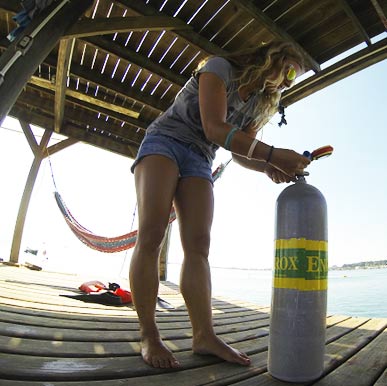Garage Days Revisited
By Joel Silverstein:
Video Credit: Courtesy Capt. Billy Deans
***NOTE:*** This video was recorded over 20 years ago.
The Witches Brew – Trimix and Nitrox Gas Mixtures
So you’re planning on going diving this weekend and need to get your cylinders filled with nitrox. Imagine that you have a choice of getting that mix from one of only six dive centers in the United States. You can go to Long Island, New York; Gloucester City, New Jersey; Key Largo or Key West, Florida; Santa Cruz, California; or Bellingham, Washington to get those tanks filled. That’s right, back in the early days of technical diving we had a choice of six dive centers in the US that would fill our tanks with oxygen enriched air. If you were an active nitrox diver, the ability to obtain breathing gas was very limited. Getting gas required logistics far beyond that of driving to the local dive shop. Yet, that did not stop people from getting the coveted breathing gas. If you were near these dive centers, it was easy. If not, creativity crept in.
Tell any diver they cannot have something and soon they will make it themselves. It did not take long for divers to start mixing gas in their garages. Dive shop owners were strongly against this practice, and the industry frowned upon it just as loudly. Yet divers were mixing gas at home more than most could have imagined. Some divers were very successful at home brewing, but others were sloppy and dangerous. Most anyone with simple math skills could calculate proper proportions of oxygen and air to make a nitrox mixture. However, mixing nitrox gas was more complex than transfilling some oxygen and topping it up with air. It required oxygen, hoses, fittings, gauges, flow meters, an oxygen analyzer, and an air compressor. In addition, it took an understanding of cleaning for oxygen-service, gas system design, heat exchange, and the dangers of adiabatic compression. Most people could put the first parts together, but it was the oxygen compatible air and oxygen cleanliness that were the missing links for many. Some divers would fill their scuba cylinders at home with a specific amount of oxygen and then have them topped off with air at the local dive shop. On the surface, this seemed a logical solution, but it violated every rule of gas mixing, and it put many people at undue risk. In some situations, it resulted in serious accidents. If they were cutting corners in one part of this process, what else was not as good as required?
For divers who wanted to do it right, they sought out training from experts like former NOAA Diving Officer, Dick Rutowski in Key Largo, Captain Billy Deans in Key West, or ANDI co-founder, Ed Betts on Long Island.. The courses offered were comprehensive and usually took two to four days to complete. For those who could not get to these rare training events, the early CompuServe internet forums were a major source for gas mixing discussions. In addition, divers would share information they garnered from the Navy and NOAA diving manuals, as well as from the commercial diving industry. Along with all the seriousness and challenges that were facing technical diving in the early days, deep diving pioneer, Capt. Billy Deans created a video that parodied decompression table creation, breathing gas analysis and gas mixing. It gives today’s divers and gas mixers an idea of what we were up against back in the early days of recreational mixed gas diving.
It was not until Technical Diving International introduced the first TDI Gas Blender Course and textbook written by Jan Neal, that gas-mixing methodology became readily available to divers worldwide. Neal’s materials legitimatized recreational gas mixing and formed the basis for what we do today in teaching divers about mixing gases for diving. The dive industry as a whole has benefited from the contributions of divers over the years to gas mixing.
Learning about mixing gas is much easier today than it was twenty years ago. A whole industry has emerged that has made the tools of the trade much easier to get; between training, gas analyzers, gas boosters, compact compressors, filtration systems and a host of other items. While divers are able to get gas mixes from most any dive center around the world, there are those who still like to mix on their own and the right stuff is easy to get. Like in most every industry, great ideas and techniques are the product of a few brave individuals who sought out knowledge and adventure, many times from the workbench in their garage.
Joel Silverstein is the author of three books on nitrox, a major contributor to the NOAA Diving Manual, and TDI Instructor Trainer # 125. Since 1989 he has mixed more than two million cubic feet of breathing gas. Contact: joel@techdivinglimited.com




